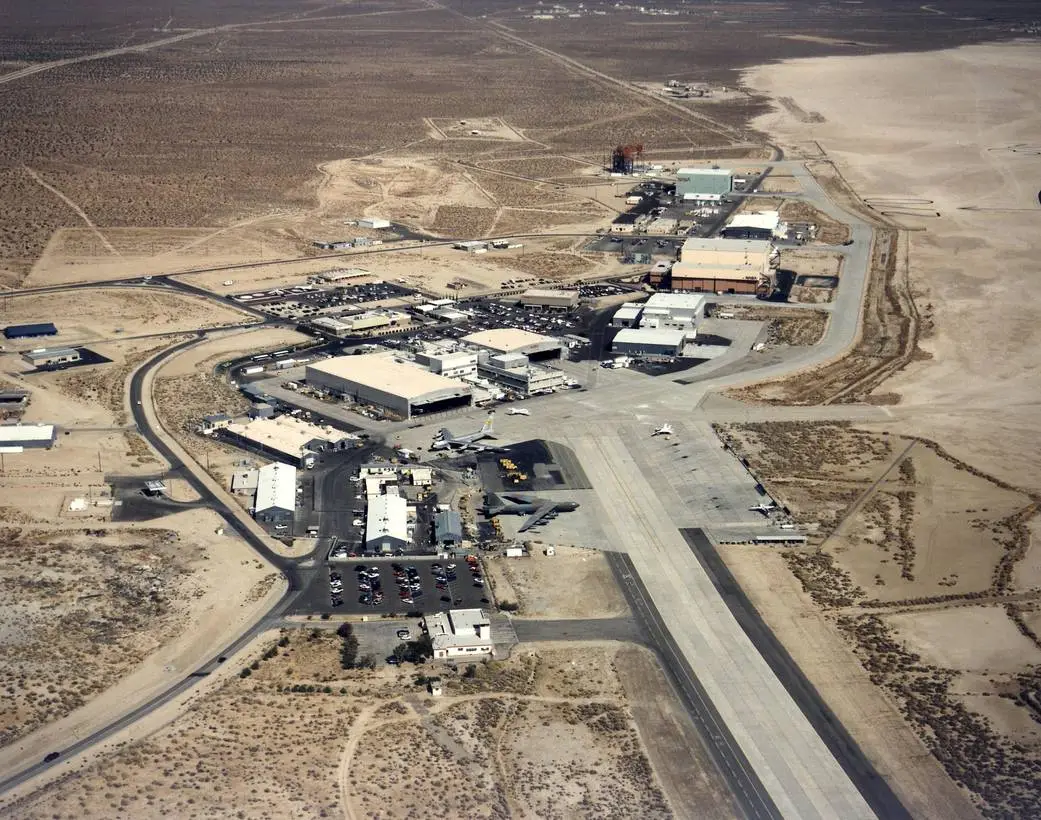The “Flight Test Files” series of articles explores the aircraft used by the Dryden Flight Research Center over the years in its pursuit of aeronautical advancements. Since the 1940s, the Dryden Flight Research Center in Edwards, CA, has built a unique and specialized capability for conducting flight research programs. This organization, composed of pilots, scientists, engineers, technicians, mechanics, and administrative professionals, has been and continues to be a leader in the field of advanced aeronautics. Located on the northwest edge of Rogers Dry Lake, the complex was originally centered around the administrative hangar building constructed in 1954. Over time, additional support and operational facilities have been added, including unique test facilities like the Thermalstructures Research Facility, Flow Visualization Facility, and Integrated Test Facility. One of the most notable structures is the space shuttle program’s Mate-Demate Device and hangar, located in Area A to the north of the main complex. The lakebed surface also features a Compass Rose, providing pilots with an instant compass heading. The Dryden complex originated at Edwards Air Force Base to support the X-1 supersonic flight program. As other high-speed aircraft entered research programs, the facility became permanent, expanding from a staff of five engineers in 1947 to nearly 1,100 full-time government and contractor employees by 2006.
Martin B-57B Canberra
During the early 1970s, a Martin B-57B Canberra (ex USAF 52-1576) took part in several NASA joint flight test programs at their Flight Research Centre within Edwards Air Force Base in California’s Mojave Desert. This particular Canberra was involved in numerous research endeavors with both NASA and it’s forebear, the N.A.C.A., but in 1974-75 it played a role in proof-of-concept testing for the Viking Mars landers, a cooperative effort with NASA’s Langley Research Center in Hampton, Virginia.
With completion of the Viking parachute tests, which took place at the Joint Parachute Test Facility in El Centro, California, the B-57B flew from Edwards a number of times to measure/analyze atmospheric turbulence as part of NASA’s effort to develop models for predicting what the Viking Mars lander might encounter during its decent in the Martian atmosphere. Additional atmospheric testing provided samples of aerosols for the University of Wyoming and clear-air turbulence data for the Department of Transportation.
The aircraft was tested over a span of many years at Edwards Air Force Base by various NASA centers for other types of research. This particular Canberra also took part in a number of important flight tests at other N.A.C.A./NASA establishments. Perhaps the most important of these took place during Project Bee with the Aircraft Engine Research Laboratory at Lewis Field in Cleveland, Ohio. These experiments proved that conventional jet engines could successfully operate with liquid hydrogen as a fuel source.
As the NASA archives record: “On 13 February 1957, the first of three successful flights was made and the fuel system worked well. The transition to hydrogen was made in two steps. The hydrogen lines were first purged, then the engine was operated on JP-4 and gaseous hydrogen simultaneously. After two minutes of operations on the mixture, Algranti [the pilot] switched to hydrogen alone. The transition was relatively smooth and there was no appreciable change in engine speed or tailpipe temperature. The engine ran for about 20 minutes on hydrogen. The pilots found that the engine responded well to throttle changes when using hydrogen. When the supply was almost exhausted, the speed began to drop. As this became apparent, Algranti switched back to JP-4 and the engine accelerated smoothly to its operating speed. The engine burning hydrogen had produced a dense and persistent condensation trail, while the other engine operating on JP-4 left no trail.”
Interestingly, Project Bee served as an important milestone in convincing NASA that liquid hydrogen would be a safe fuel for the Saturn V rockets which would serve the Apollo lunar missions of the 1960s and 70s.
Later, in 1982, the B-57B aircraft returned to the (then) Ames-Dryden Flight Research Facility (since renamed for lunar astronaut Neil Armstrong) for more Langley-sponsored turbulence testing. These experiments provided data on mountain waves, jet streams, convective turbulence, and clear-air turbulence; valuable details for improving airliner operational safety.

































